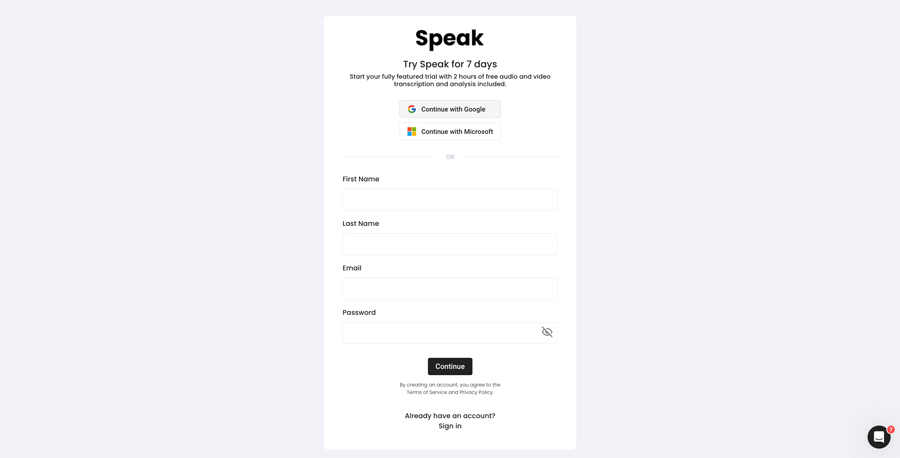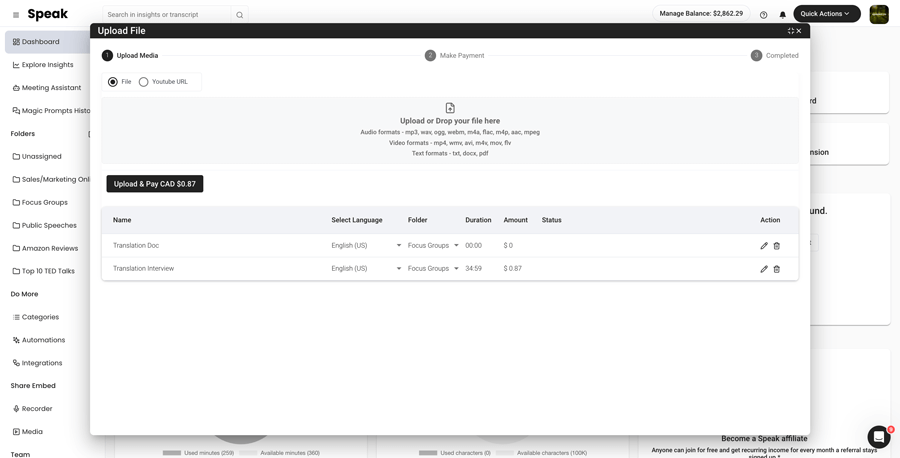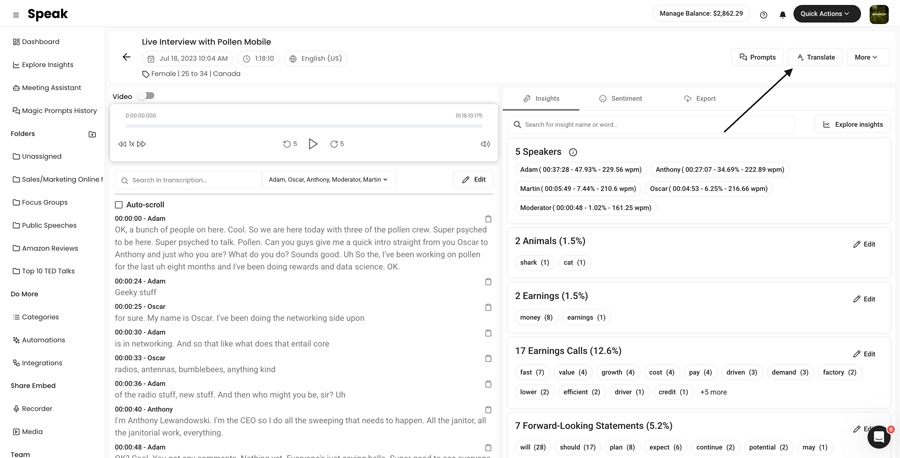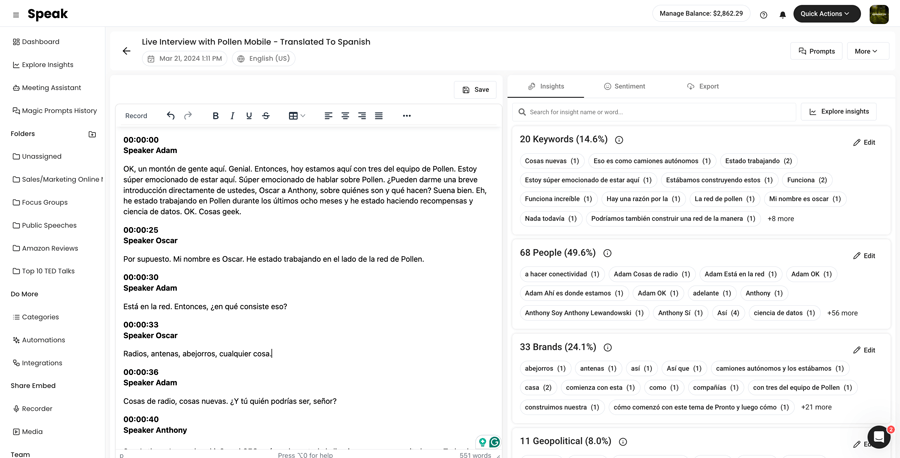How To Translate German to Hmong
Translating German to Hmong is super simple!

Step 1: Register for Speak
Register for Speak using this link.
Once you register, you can instantly begin translating your German to Hmong file(s).

Step 2: Upload Your German file(s)
As soon as you log in, you will be redirected to the dashboard.
Once there, you can select the Quick Action "New Upload".
In Speak, you can seamlessly upload, transcribe and translate audio, video and text files all at once!

Step 3: Translate Your German file(s) to Hmong
Once the file is uploaded, simply visit your file and select "Translate".
If it is an audio and video file, Speak will ask you if you want to keep the speaker names and timestamps in the translation.
Want to translate many files at once? No problem!
You can view the files you want to automatically translate from German to Hmong from the folder level and instantly translate as many files as you need with our artificial intelligence translation in just a few clicks.

Step 4: That's It! View, Analyze, Modify & Export Your New Hmong file(s)
Once the translation is done, you will be alerted and you will see a new document in the same folder your original file is in.
The file will be named the same but with a dash indicating that it is the translated version.
Need support with your German translation?
We are always here and happy to help at Speak!
Just send us a message on live chat on the bottom right corner and we will ensure you are set up for success.
Interested in translating German or other languages to different languages? View our entire list of supported translation languages here.
Automatic, accurate, instant AI translation from German to Hmong is here for you.
Register for Speak using this link and begin translating German to Hmong today.
Unlocking New Doors: The Power of German to Hmong Translation
At a time when connectivity across the globe is more important than ever, breaking language barriers plays a pivotal role in fostering understanding and collaboration. The translation from German to Hmong, two linguistically and culturally rich languages, embodies this pursuit of global connectivity. With advanced AI translation technologies, such as those offered by Speak AI, accessing, understanding, and sharing knowledge across these languages has never been more seamless or efficient.
The Significance of German-to-Hmong Translation in Today's World
In our increasingly interconnected global landscape, the ability to translate content from German to Hmong opens up vast opportunities for both researchers and businesses. For researchers, it signifies access to a broader spectrum of academic work and primary sources, while for businesses, it taps into new markets and communities, enhancing communication and mutual understanding.
Advancements in AI Translation: A Game-Changer
With the integration of NLP, large language models, and Generative AI, platforms like Speak AI are at the forefront of revolutionizing translation services. These technologies not only enable accurate and context-aware translations but also offer significant time and cost savings compared to traditional translation services.
Benefits of Automatic German to Hmong Translation
- Enhanced Accessibility: Break down language barriers and make content accessible to a wider audience.
- Cost Efficiency: Leverage AI to reduce the cost of translation services significantly.
- Time Savings: Automatic translations are completed in a fraction of the time needed for manual translations.
- Accuracy and Context Awareness: Advanced algorithms ensure translations are not only accurate but also contextually relevant.
Real-World Application of German to Hmong Translations
From academic collaborations, business expansions, to cultural exchanges, the applications of translating German to Hmong are vast and varied. Researchers can delve into previously inaccessible studies, while businesses can tailor their offerings to resonate better with the Hmong-speaking market.
The Landscape: German and Hmong in the World
Geographical and Demographical Insights
German is predominantly spoken in Germany, Austria, Switzerland, and parts of Belgium and Liechtenstein, boasting over 130 million speakers worldwide. Hmong, while lesser-known, has a significant presence in Southeast Asia, particularly in Laos, Thailand, Vietnam, and China, as well as sizable communities in the United States, numbering over 4 million speakers globally.
Historical Context and Modern Implications
The interaction between German and Hmong speakers is a testament to our globalized society. Historically, these interactions might have been limited, but today, they symbolize the potential for cultural, academic, and economic exchanges between Europe and Southeast Asia, as well as within Hmong diasporas in the West.
Unveiling the Rich Tapestry: German and Hmong
Cultural and Linguistic Heritage
German, a Germanic language, is known for its compound nouns and robust syntactic structure. Hmong, a Hmong-Mien language, is noted for its tonal system and lack of verb conjugation. This linguistic diversity not only underscores the complexity of translation but also highlights the beauty of cross-language communication.
Fun Facts: From Phonology to Festivities
German is known for its lengthy compound words, whereas Hmong is celebrated for its rich oral tradition and use of embroidery in storytelling. Both languages boast unique alphabets, with Hmong's Pahawh script being one of the last writing systems created in the 20th century.
Uniting Through Differences
Despite their differences, both German and Hmong share a deep respect for tradition and storytelling. This common ground fosters a fascinating intersection for translation, where stories and knowledge are passed between cultures, enriching both.
Embracing the Future: The Impact of AI Translation
As Speak AI continues to refine and enhance our translation technologies, the promise of bridging language gaps between German and Hmong speakers becomes ever more tangible. For researchers and businesses alike, these advancements herald a new era of communication, collaboration, and understanding.
Join the Movement
With over 150K users and a 4.9 rating on G2, Speak AI is dedicated to transforming how we interact with languages, including German to Hmong translations. Through our AI Meeting Assistant and state-of-the-art translation services, we're not just breaking down language barriers—we're building bridges.
Why Wait? Discover Speak AI Today
Whether you're looking to expand your research horizons, grow your business, or simply explore new cultures, Speak AI's translation solutions are here to empower your journey. Visit us to learn more and join the global community of innovators, thinkers, and creators united by the power of translation.
---
Understanding German and Hmong: Locations, Stats, and History
German and Hmong languages emanate from vastly different historical, geographical, and cultural backgrounds. German is widely spoken in Central Europe, serving as an official language in Germany, Austria, Switzerland, and Belgium, and is the mother tongue to over 130 million people globally. On the other hand, Hmong is primarily found in Southeast Asian countries like Laos, Thailand, and Vietnam, and significant expatriate communities in the United States, with a global speakership exceeding 4 million.
Fun Facts about German and Hmong
German's penchant for creating long compound words (Donaudampfschifffahrtsgesellschaftskapitän being a famous example) starkly contrasts with the rich oral traditions of Hmong culture, which relies heavily on storytelling and textile art to pass down its heritage. Interestingly, the Hmong language didn’t have a written form until the 1950s, showcasing the innovation within linguistic evolution.
Divergence and Convergence between German and Hmong
While German utilizes a complex system of grammar and gender with a vast vocabulary, Hmong is a tonal language with a unique set of phonetic sounds and lacks gendered nouns. Intriguingly, both languages have adapted over time to include words and concepts from other languages, reflecting their speakers' histories of migration and adaptation. This underscores a fundamental similarity between all languages: they are living, evolving entities shaped by human experience.
Translate German To These Other Supported Languages:
- Translate German-to-Afrikaans
- Translate German-to-Albanian
- Translate German-to-Amharic
- Translate German-to-Arabic (Egypt)
- Translate German-to-Arabic (Iraq)
- Translate German-to-Arabic (Israel)
- Translate German-to-Arabic (Jordan)
- Translate German-to-Arabic (Kuwait)
- Translate German-to-Arabic (Lebanon)
- Translate German-to-Arabic (Oman)
- Translate German-to-Arabic (Palestinian Authority)
- Translate German-to-Arabic (Qatar)
- Translate German-to-Arabic (Saudi Arabia)
- Translate German-to-Arabic (Syrian Arab Republic)
- Translate German-to-Arabic (United Arab Emirates)
- Translate German-to-Arabic Modern Standard (Bahrain)
- Translate German-to-Armenian
- Translate German-to-Assamese
- Translate German-to-Aymara
- Translate German-to-Azerbaijani
- Translate German-to-Bambara
- Translate German-to-Basque
- Translate German-to-Belarusian
- Translate German-to-Bengali
- Translate German-to-Bhojpuri
- Translate German-to-Bosnian
- Translate German-to-Bulgarian
- Translate German-to-Catalan
- Translate German-to-Cebuano
- Translate German-to-Chinese (Simplified)
- Translate German-to-Chinese (Traditional)
- Translate German-to-Corsican
- Translate German-to-Croatian
- Translate German-to-Czech
- Translate German-to-Danish
- Translate German-to-Dari
- Translate German-to-Dhivehi
- Translate German-to-Dogri
- Translate German-to-Dutch
- Translate German-to-English
- Translate German-to-English (Australia)
- Translate German-to-English (Indian)
- Translate German-to-English (Irish)
- Translate German-to-English (New Zealand)
- Translate German-to-English (Scottish)
- Translate German-to-English (South African)
- Translate German-to-English (United Kingdom)
- Translate German-to-English (United States)
- Translate German-to-Esperanto
- Translate German-to-Estonian
- Translate German-to-Ewe
- Translate German-to-Farsi (Persian)
- Translate German-to-Filipino Tagalog
- Translate German-to-Finnish
- Translate German-to-French
- Translate German-to-French (Canada)
- Translate German-to-Frisian
- Translate German-to-Galician
- Translate German-to-Georgian
- Translate German-to-German
- Translate German-to-German (Swiss)
- Translate German-to-Greek
- Translate German-to-Guarani
- Translate German-to-Gujarati
- Translate German-to-Haitian Creole
- Translate German-to-Hausa
- Translate German-to-Hawaiian
- Translate German-to-Hebrew
- Translate German-to-Hindi
- Translate German-to-Hmong
- Translate German-to-Hungarian
- Translate German-to-Icelandic
- Translate German-to-Igbo
- Translate German-to-Ilocano
- Translate German-to-Indonesian
- Translate German-to-Irish
- Translate German-to-Italian
- Translate German-to-Japanese
- Translate German-to-Javanese
- Translate German-to-Kannada
- Translate German-to-Kazakh
- Translate German-to-Khmer
- Translate German-to-Kinyarwanda
- Translate German-to-Konkani
- Translate German-to-Korean
- Translate German-to-Krio
- Translate German-to-Kurdish
- Translate German-to-Kurdish (Sorani)
- Translate German-to-Kyrgyz
- Translate German-to-Lao
- Translate German-to-Latin
- Translate German-to-Latvian
- Translate German-to-Lingala
- Translate German-to-Lithuanian
- Translate German-to-Luganda
- Translate German-to-Luxembourgish
- Translate German-to-Macedonian
- Translate German-to-Maithili
- Translate German-to-Malagasy
- Translate German-to-Malay
- Translate German-to-Malayalam
- Translate German-to-Maltese
- Translate German-to-Maori
- Translate German-to-Marathi
- Translate German-to-Meiteilon (Manipuri)
- Translate German-to-Mizo
- Translate German-to-Mongolian
- Translate German-to-Myanmar (Burmese)
- Translate German-to-Nepali
- Translate German-to-Norwegian
- Translate German-to-Nyanja (Chichewa)
- Translate German-to-Odia (Oriya)
- Translate German-to-Oromo
- Translate German-to-Pashto
- Translate German-to-Persian
- Translate German-to-Polish
- Translate German-to-Portuguese
- Translate German-to-Portuguese (Brazilian)
- Translate German-to-Portuguese (Portugal)
- Translate German-to-Punjabi
- Translate German-to-Quechua
- Translate German-to-Romanian
- Translate German-to-Russian
- Translate German-to-Samoan
- Translate German-to-Sanskrit
- Translate German-to-Scots Gaelic
- Translate German-to-Sepedi
- Translate German-to-Serbian
- Translate German-to-Sesotho
- Translate German-to-Shona
- Translate German-to-Sindhi
- Translate German-to-Sinhala
- Translate German-to-Sinhala (Sinhalese)
- Translate German-to-Slovak
- Translate German-to-Slovenian
- Translate German-to-Somali
- Translate German-to-Spanish
- Translate German-to-Spanish (Mexico)
- Translate German-to-Sundanese
- Translate German-to-Swahili
- Translate German-to-Swedish
- Translate German-to-Tajik
- Translate German-to-Tamil
- Translate German-to-Tatar
- Translate German-to-Telugu
- Translate German-to-Thai
- Translate German-to-Tigrinya
- Translate German-to-Tsonga
- Translate German-to-Turkish
- Translate German-to-Turkmen
- Translate German-to-Twi (Akan)
- Translate German-to-Ukrainian
- Translate German-to-Urdu
- Translate German-to-Uyghur
- Translate German-to-Uzbek
- Translate German-to-Vietnamese
- Translate German-to-Welsh
- Translate German-to-Xhosa
- Translate German-to-Yiddish
- Translate German-to-Yoruba
- Translate German-to-Zulu



